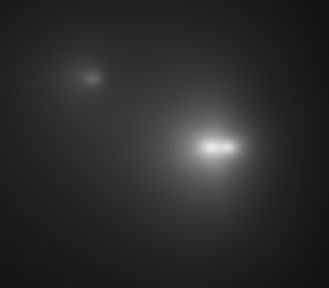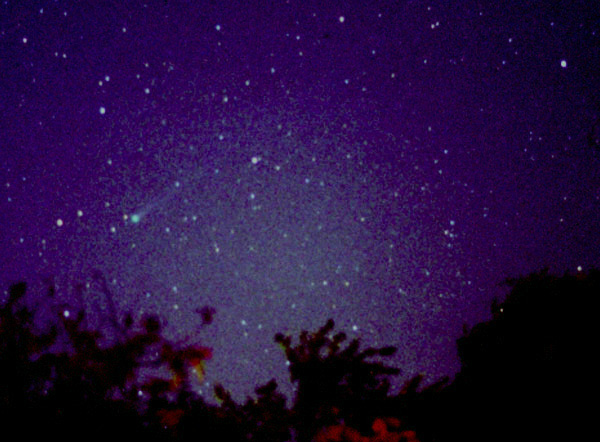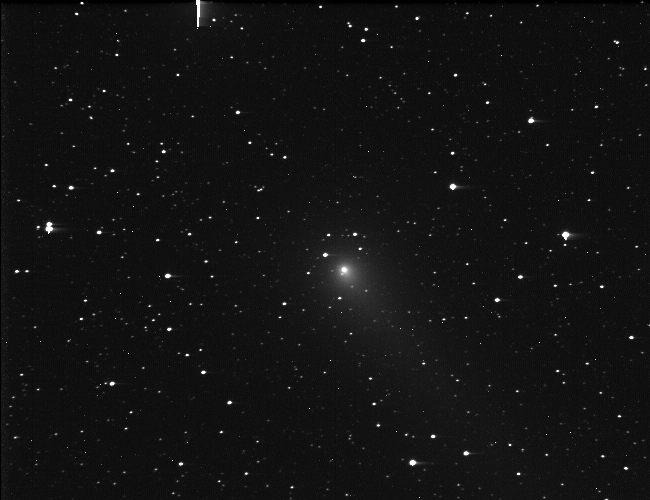
Perihelion: 2001 May 24.52, q = 0.779 AU
At the beginning of the 21st Century the discovery of comets and near-Earth asteroids was dominated by the first of the comprehensive sky surveys, the LIncoln Near-Earth Asteroid Research (LINEAR) program run by MIT’s Lincoln Laboratory and based at White Sands Missile Range in New Mexico, that had become fully operational in 1998 (and which is discussed in a future “Special Topics” presentation). Of the 42 ground-based comet discoveries made in 2001, 20 of these were made by LINEAR (with a handful of these being shared with a couple of the other surveys operational at the time), and indeed, five of the first six comet discoveries that year were made by LINEAR. LINEAR would continue dominating discoveries for another few years before similarly comprehensive surveys started going on-line and producing their own impressive rates of detecting comets and near-Earth asteroids.
The first moderately bright naked-eye comet of the 21st Century was discovered by LINEAR on January 15, 2001, with pre-discovery images extending back to January 3 later being identified. The comet was a relatively dim 16th or 17th magnitude at the time of its discovery, and although the moderately small perihelion distance suggested it would become bright enough for visual observations, there otherwise didn’t seem to be anything unusual about it, and it brightened slowly as it approached the inner solar system. Around mid-March, however, it underwent a rapid increase in brightness, from about 13th magnitude at that time to close to 8th magnitude shortly after the beginning of April.

The reason for Comet LINEAR’s dramatic increase in brightness soon became apparent. Around the end of April images taken with large telescopes revealed that the comet’s nucleus had split into two fragments, and from astrometric measurements of these Zdenek Sekanina at the Jet Propulsion Laboratory in California was able to determine that the splitting event had occurred between mid- and late March – right at the time that brightness upsurge began.
Comet LINEAR’s brightness surge did not stop then, although it proceeded further in fits and starts rather than continuously. By the beginning of May its brightness had increased to 6th magnitude; shortly thereafter it became inaccessible from the northern hemisphere, although it remained visible from the southern hemisphere, with observers there reporting it as being close to 5th magnitude during the latter part of that month before it passed through conjunction with the sun (50 degrees south of it) in early June, after which it emerged into the southern hemisphere’s morning sky.

Shortly before the end of May the secondary nucleus began its own fragmenting, which triggered another outburst in brightness that became apparent around the middle of June. It so happened that I was in Zimbabwe at the time preparing to observe the total solar eclipse on June 21, and on the morning of the 16th I could easily detect the comet with my unaided eye near magnitude 3.5; I could detect a two-degree tail in binoculars, and could trace this tail out to almost twice that long in photographs I took then.
By the latter part of June Comet LINEAR had faded slightly, to about 4th magnitude, and also had become accessible again from the northern hemisphere. It passed closest to Earth (0.24 AU) at the very end of the month and faded somewhat steadily after that point; there were reports of a brief outburst around the middle of July, but within another week it had dropped below naked-eye visibility. After going through opposition at the beginning of August it faded more rapidly, with visual observations remaining possible until early September and the final observations being obtained three months later.

More from Week 25:
This Week in History Special Topic Free PDF Download Glossary
Ice and Stone 2020 Home Page


